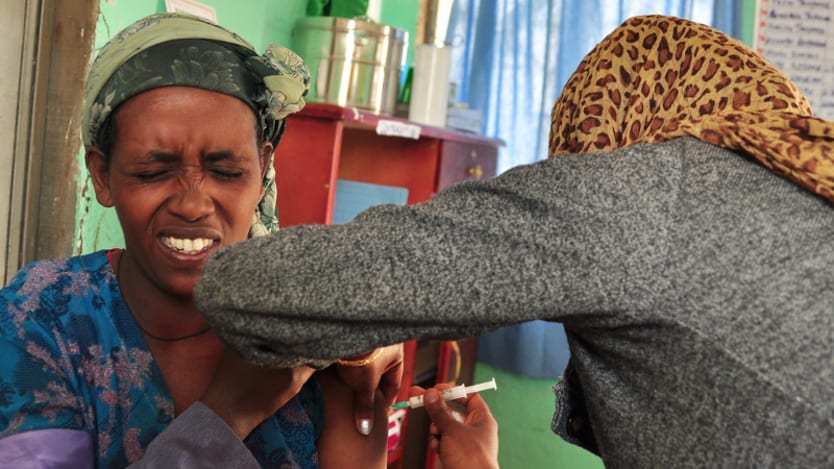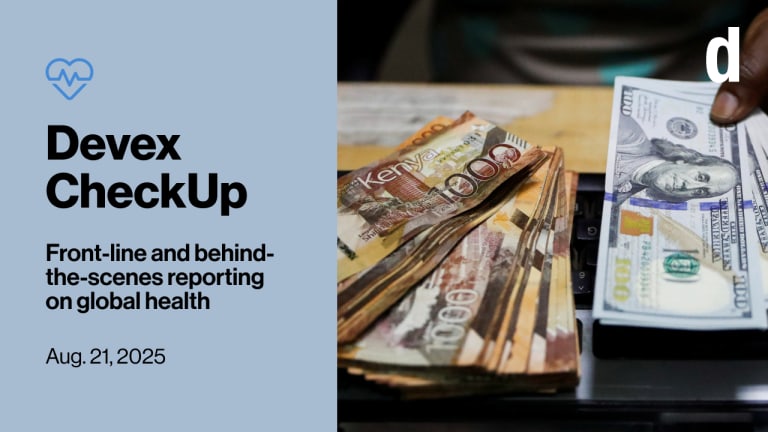
UNITED NATIONS — Increasingly, women and girls across different strata of society are experiencing a greater divide as they seek to obtain access to sexual and reproductive health care.
As inequality continues to rise within countries, it is creating far more than a financial gap among the rich and the poor, the annual flagship report of the U.N. Population Fund, shows. The report was launched Tuesday at the United Nations.
There’s an unmet demand for family planning in developing countries that is greatest among women in the poorest 20 percent of households, according to the World Population 2017 report, “Worlds Apart: Reproductive Health and Rights in an Age of Inequality.” Income gaps widened in 34 countries between 2008 to 2014, while 68 countries had larger “gender gaps,” in 2016 than they did the year before.
“I challenge anybody to show me a place where inequality is not a problem to some degree,” Richard Kollodge, the editor of the report, told Devex before a press briefing at the U.N. on Tuesday.
The original findings — collected largely through demographic and health surveys — challenge the popular notion that inequality is purely a manifestation of economics. Growing disparities within countries can have devastating health and societal consequences for women, who, globally, still earn 77 percent of what men bring in. These difference are most pronounced when women’s lives are analyzed by their financial, education, and geographic demographics.
“We note big gaps between urban and rural, and between those with a lot of education and those with very little education. Those are the main ways we look at inequality. But there are other dimensions for rural, urban, and less educated that factor into the report,” said Kollodge.
“We are careful not to suggest that just by reducing inequality of sexual reproductive health you fix the economic inequality problem. But we are saying if you do not address these inequalities, you probably never achieved economic equality, or anything that looks like it.”
Generally, countries with higher GDP per capita experience less gender inequality, the report shows. It also intrinsically ties inequality to gender, including unequal access to sexual and reproductive health care.
In a majority of countries, contraceptive prevalence is lower among women who are poorer, live in rural areas, or are less educated than their richer, urban, and more highly educated counterparts. There are some exceptions to this. In Bangladesh, Bhutan, Cambodia, and Thailand, for example, where family planning is more equitable, contraceptive prevalence rates are higher among the poorest 20 percent of the population than among the richest 20 percent.
UNFPA Executive Director Natalia Kanem also presented the world population report in London on Tuesday, when she spoke to the ripple effects this lack of empowerment and independence can have on an individual and society.
“The poorest women have the least power to decide whether, when, and how often to become pregnant. The poorest women also have the least access to quality care during pregnancy and childbirth. This inequity has lasting repercussions for women's health, for their work life, for their earnings potential, and for their contribution to their nations' development and elimination of poverty," she said. "Countries seeking to tackle economic inequality should start by addressing related and underlying inequalities, such as in reproductive health."
Places of residence can also help dictate access to reproductive health care. The access gap for rural and urban women aged 15-49 who are married or in a union is most pronounced in Eastern and Southern Africa (by 17 percent), but not as evident in Latin America, the Caribbean, Eastern Europe, and Central Asia, where the access gap between rural and urban women ranges from 6 to 8 percent.
Overall, the greatest “wealth-based inequalities” to meet family planning needs are in West and Central Africa, where women from the richest 20 percent of households in 13 of the 20 countries are twice as likely to have their contraceptive needs met as women in the poorest 20 percent of households, according to the report.
Wealth-based inequalities are the least evident in Asia and the Pacific, Eastern Europe and Central Asia, and Latin America and the Caribbean.
U.N. Secretary-General António Guterres formally appointed Kanem — a medical doctor and a native of Panama — as executive director of UNFPA earlier this month. She most recently served as deputy executive director of the organization following the death of its former leader, Babatunde Osotimehin, last summer.
Kanem formally took the reigns of UNFPA, one of the smallest U.N. agencies, as it announced its new strategic plan for 2018 through 2021. The three main goals of this plan are to end preventable maternal deaths, end unintended pregnancies, and end gender-based violence, as well as child marriage, by 2030.
While the rate of maternal deaths nearly halved from 2000 to 2015, the maternal mortality ratio in least developed countries still rests at 436 deaths per 100,000 births — much higher than the 12 deaths per 100,000 births in developed countries.
And each year, there are 89 million unintended pregnancies and 48 million abortions, according to the Guttmacher Institute.
"Stopping the downward spiral of inequality will require a new vision for inclusive societies where all human potential is realized, and this is the vision of the ... strategic plan for the upcoming period,” Kanem said Tuesday.
UNFPA is also facing a funding gap of $700 million on what it requires through 2020, she added.
The U.S., once one the UNFPA’s largest donors, cut its support to the agency this year. Annually, that support totalled an average of $69 million. In making its cuts, Washington cited UNFPA’s work with the Chinese government on forced sterilization and coerced abortion, although there is no evidence the agency engages in these practices.
"We have to explain ourselves better, and we have to be more vocal and more visible and more willing to go for it, even to those who disagree, so that we have the opportunity for dialogue and to discuss how this is really life-changing," Kanem said.
All of the data in this report is being presented for the first time. One of UNFPA’s recommendations is that progress is possible, but only with the right policy decisions
“It’s not only important to have good data, but to use data in a new way to look at access to services and see who has access to those services. Is it the poor, the rich, or a little bit of both?” Kollodge explained.
“When people talk about inequality they talk about money — who has it, who does not — and I think that most people do not think of inequality in these terms. In reality, there are many dimensions that reinforce inequality and it reinforces these other inequalities and the ones we are focusing on have to do with women’s rights.”
Read more international development news online, and subscribe to The Development Newswire to receive the latest from the world’s leading donors and decision-makers — emailed to you free every business day.









